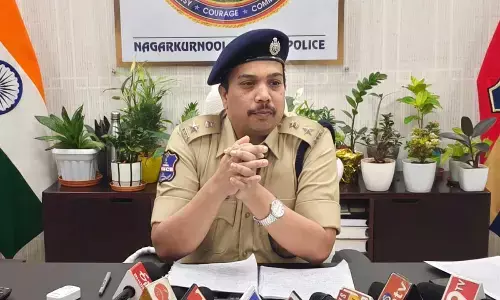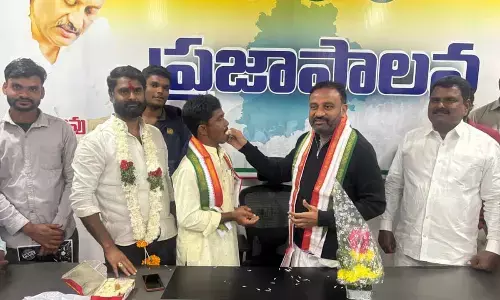International Day of Women and Girls in Science: More Women in Research are Needed, Says Mr Anurag Gupta

International Day of Women and Girls in Science: More Women in Research are Needed
"The world needs more problem-solvers and innovators than consumers", Says Anurag Gupta, Co-Founder of Stemrobo Technologies, an Ed-tech startup that caters to the K-12 segment.
The International Day of Women and Girls in Science is observed on February 11 is enforced by UNESCO and UN-Women, in collaboration with institutions and civil society partners with an aim to promote women and girls in science. This Day is an opportunity to promote equal access and participation in science for women and girls. For UNESCO, Gender equality is a global priority, and support for young women, their education, and their ability to make their ideas heard for development and peace.
Anurag Gupta, Co-Founder of Stemrobo Technologies
Mr Anurag Gupta is the Co-Founder of Stemrobo Technologies, it is an Ed-tech startup that caters to the K-12 segment and offers them training in coding, AI, and ML. He shares his vision with The Hans India on this day on how technology can be a part of the solution for empowering rural women and girls.
1. Kindly brief us about your company and what is the problem statement that you are solving & what were the intricacies in getting started and scaling up? How did you overcome them? When did you start and where are you based?
STEMROBO Technologies is headquartered in New Delhi-NCR, founded in 2016 the company aims at providing a platform to students across the globe to harness learning and innovation technologies in the field of STEM Education. At that time, technology and creativity in the country were below average, which, in turn, slowed down the country's progress. New-age inventions and 21st-century skills were seen as something that only the privileged could appreciate. STEMROBO, therefore, believed in encouraging and motivating the students by giving them access to strategic technology that could lead to innovations and the country's development. We concentrate on six main innovations, including block-based programming, app creation, App-development, Artificial Intelligence (AI) and Python, 3D Designing, Arduino Programming, and Fun with Electronics. We have developed Tinkering and Innovation Labs in more than 1700 schools and work with more than 10,00,000 students and teachers to foster students' out-of-the-box thinking and technological advancement. The goal and focus of STEMROBO are to solve real-world problems by using techniques and project-based learning while providing an Immersive Learning Experience that caters to essential 21st-century skills. STEMROBO is becoming a One Stop Solution for All the Innovation Needs of schools and students. EdTech gives you scale, a multiple and networking effect; and the challenges are how to make it pervasive as EdTech delivery is still dependent on gadgets like Laptop, PC, SmartPhones and good broadband which not everyone in the country possesses or can afford.
2. What role Stemrobo is Playing to promote women's inclusion in the field of science and how you are ensuring an inclusive and unbiased environment at your organization?
We have two modules of incorporating activity-based knowledge i.e online & offline, but due to the pandemic, the credit for our 90 percent seamless online teaching goes to our team, which includes engineers, the majority of whom are women engineers with an M.tech or B.Tech background, has begun to take classes directly with students due to a shortage of trained personnel in new skills, and we are also training educators or school teachers. Our goal is to establish a welcoming environment that is devoid of prejudice. We have a network of housewives with technical education degrees, assisting in the teaching of block coding and Python. Stemrobo has a part-time network of housewives who are trained by experts, then go through a selection process before being allowed to teach the classes. We have plans to increase the number of housewives on our team as they interact effectively with the kids. They usually teach coding in a live session at a time that is convenient for them. There is still a significant disparity in access and opportunity between boys and girls, men and women, beginning in primary school and continuing through higher education and job search. When it comes to topics like mathematics or science, gender stereotypes play a role in discouraging females from pursuing careers in these fields, we have a zero-tolerance policy for gender disparity when it comes to incorporating knowledge and skills in the students. To accelerate the skilling programme in the rural areas Stemrobo has introduced AI Connect a unique and integrated Cloud-based software platform where students will have free access to do block-based coding, python. Using this curriculum, the tinkerers will have access to do Data Analytics, Python, Computer Vision, Coding, Machine Learning, Algorithms, developing Robots, Games but also helps in building artificial intelligence skills which can solve day to day real-life problems.
3. Why is it important to nurture and increase the number of females working in science to attain sustainability goals?
The world needs more problem-solvers and innovators than consumers. More women in research are needed for reasons other than justice and ethics: having more women in labs, clinics, and clinical trials will improve our planet, as the gender divide has been a significant barrier for women working in science throughout history. Despite the fact that they never ceased studying, first as amateurs and subsequently as professionals, they stayed outside of scientific organizations and held low-level positions. Women are finally getting into research institutes, but they still have a long way to go in terms of peer approval and gatekeeper acceptance. Science and gender equality are both essential for accomplishing internationally agreed-upon development goals like the 2030 Agenda for Sustainable Development. Many girls and women are held back by biases, social conventions, and expectations, which have an impact on the quality of their education and the subjects they study. STEM (science, technology, engineering, and mathematics) education and, as a result, STEM jobs are under-represented. Women and girls must be empowered to not just participate in STEM professions, but also to lead and invent.
4. What's your take on the government? Efforts to promote inclusions at the root level and what changes do you want?
For a long time, equity in Indian science has been a hot matter of debate but what govt. did in the past few years is truly appreciable although the progress is slow we are definitely on the right path, in terms of improving women inclusion in science govt's SERB-POWER (Promoting Opportunities for Women in Exploratory Research) scheme, which aims to reduce gender disparities in science and engineering research funding in Indian academic institutions and research and development (R&D) laboratories, and address women scientists' disparities, is truly commendable and unprecedented. Multifaceted initiatives have been launched by the department of science and technology to encourage women's entrepreneurship under Start-up India-Stand up Indian we have Rajiv Gandhi Scheme for Empowerment of Adolescent Girls - Digital Laado have been introduced by the government to build awareness about the importance of educating the girl child and empowering them to join the workforce and the flagship initiative of Niti Ayog, Atal Innovation Mission the objective to foster curiosity, creativity, and imagination in young minds are some efforts for which the govt should be appreciated for but along with this, the government should aggressively work on enhancing awareness among policymakers to improve and provide equal access to STEM education and career opportunities and spread STEM knowledge across all sectors of society.
5. What are the bottlenecks that need to be addressed in order to achieve a significant ratio of women & girls in science?
While a no. of impediments are in the force deviating us from achieving the full potential, mainly what we have witnessed is that the thought process of Indian Parents or we could say what Indian society perceive of this scenario is the major hurdle that is blocking the path towards sustainable development as STEM occupations are frequently perceived as masculine, and teachers and parents don't understand the potential behind nurturing skills in Science, Technology, Engineering, and Mathematics. These fields tend to perpetuate rigid, restrictive, cultures that aren't much supportive of or appealing to women plus there are few female scientists and engineers in books, television, and popular culture, females have fewer role models to stimulate their interest in these disciplines.
6. How Technology can be a part of the solution for empowering rural women & girls?
More female students than ever before attend school in rural India, yet the overall quality of education in rural areas isn't at par with that of urban cities, and those schools are severely under-resourced and the infrastructure aren't aligned with the needs of the digital age, although the progress is slow we are definitely on the right track. Rural girls' education is impacted by a variety of reasons, including a lack of family and societal support, a lack of skilled teachers, violence, child marriage, and prejudice against the rural community, among others. This is especially true when it comes to their participation in STEM disciplines and, as a result, STEM professions. More scientists and innovators are needed, and only proper STEM education can help us achieve this goal. We certainly need more women engineers, technicians, scientists, and researchers in India, with women accounting for 48% of the population, and it is up to all of us to demonstrate to girls and young women that their contributions, creativity, and abilities are of enormous value and potential. STEM, in my opinion, is more than just a collection of subjects; it is a way of living, a way of teaching, and a way of learning. The focus should be on Real World Problem solving Techniques and Project-Based Learning, by Offering an Immersive Learning Experience that caters to 21st Century key skills.


















